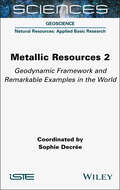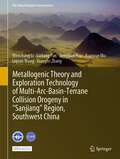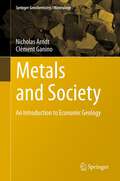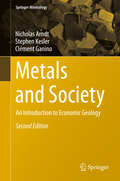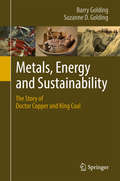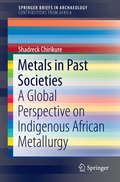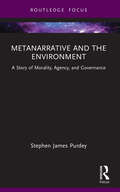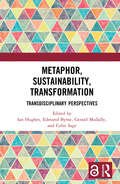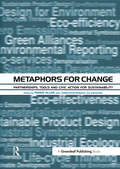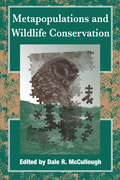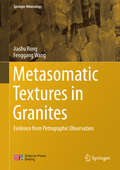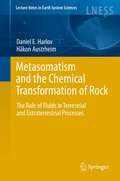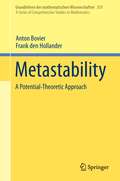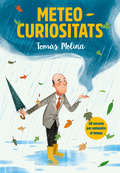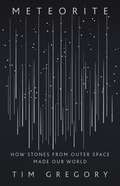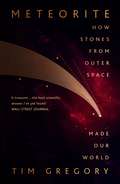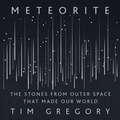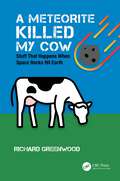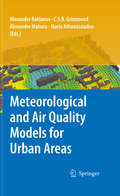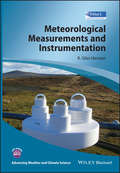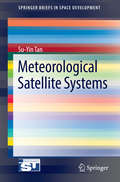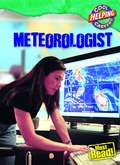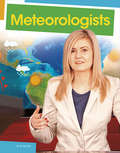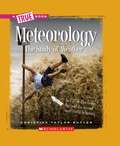- Table View
- List View
Metallic Resources 2: Geodynamic Framework and Remarkable Examples in the World
by Sophie DecréeMetallic resources play a huge role in many fields: in the energy transition, the development of new technologies and the production and storage of green energy. Metallic Resources 2 presents various studies in notable metallogenic regions or deposits worldwide that enable us to tackle the question of the concentration of metals, especially strategic metals, in various geodynamic settings. An understanding of the geological processes that lead to the formation of deposits and influence their concentrations in the Earth's crust is of the utmost importance when it comes to uncovering new mineral resources. This book puts forward various different methodological approaches necessary in the study of deposits of metallic resources, from field observations to microanalysis. A study of specific geo-politico-economic frameworks is also presented.
Metallogenic Theory and Exploration Technology of Multi-Arc-Basin-Terrane Collision Orogeny in “Sanjiang” Region, Southwest China (The China Geological Survey Series)
by Wenchang Li Guitang Pan Zengqian Hou Xuanxue Mo Liquan Wang Xiangfei ZhangThis open access book presents a new structural model of “multi-arc-basin-terrane system” based on the in-depth research of the Nujiang-Lancangjiang-Jinshajiang region, especially several Paleo-Tethys ophiolitic mélange belts and sets of arc-basin systems, and a new orogenic model of “The Hengduan shan Mountains” based on penetrated research on spatial-temporal framework and orogenic models of different orogenic belts under large-scale strike-slip-shear-nappe structures evolution. The authors paid special attention on the coupling relation between orogeny and metallogenesis. The metallogenesis and dynamic process are probed under the crust–mantle interaction and material-energy exchange-transmission background and the tectonic units evolution. The ore genesis and distribution of deposits have been thoroughly analyzed, and the metallogenic theories of "multi-arc-basin-terrane" and "intracontinental tectonic transformation" in the Nujiang-Lancangjiang-Jinshajiang region have been carried out. This book also illustrates how to explore metallic deposits in the Nujiang-Lancangjiang-Jinshajiang region by using the metallogenic regulations. Meanwhile, this book has high reference value for researchers working in the fields of basic geology, environmental geology, and energy geology.
The Metallurgy of Roman Silver Coinage
by Kevin Butcher Jane Evans Vanessa Pashley Matthew Ponting Christopher Somerfield Kevin Butcher Matthew Ponting Jane Evans Vanessa Pashley Christopher SomerfieldThe fineness of Roman imperial and provincial coinage has been regarded as an indicator of the broader fiscal health of the Roman Empire, with the apparent gradual decline of the silver content being treated as evidence for worsening deficits and the contraction of the supply of natural resources from which the coins were made. This book explores the composition of Roman silver coinage of the first century AD, re-examining traditional interpretations in the light of an entirely new programme of analyses of the coins, which illustrates the inadequacy of many earlier analytical projects. It provides new evidence for the supply of materials and refining and minting technology. It can even pinpoint likely episodes of recycling old coins and, when combined with the study of hoards, hints at possible strategies of stockpiling of metal. The creation of reserves bears directly on the question of the adequacy of revenues and fiscal health.
Metals and Society
by Nicholas Arndt Clément GaninoIn the second edition Steve Kesler (University of Michigan) has been added as an author to rewrite some chapters. The motivation for this revised edition is to more intensively address economic issues that surround the exploitation of mineral resources. This emphasis gives the book a unique character. With these sections Metals and Society deals with issues that pervade much of current science reporting - the rate of exploitation of natural resources, the question of when or if these resources will be exhausted, the pollution and social disturbance that accompanies mining, the compromises and challenges that arise from the explosion of demand from China, India and other rapidly developing countries, and the moral issues that surround mining of metals in lesser developed countries for consumption in the "first-world" countries. With its dual character, the book will be useful as an introductory text for students in the earth sciences and a reference volume for students, teachers and researchers of geography, economics and the social sciences.
Metals and Society
by Nicholas Arndt Stephen Kesler Clément GaninoThis book is a comprehensive overview of economic geology for the general geologist and anyone else interested in the minerals industry and the global supply of raw materials. It includes some thought-provoking statements and questions for discussion on globalisation and current practices in the minerals industry. In the second edition, all chapters have been extensively revised, and a new author has been added to increase coverage of some mineral deposits and topics. The economic issues surrounding the exploitation of mineral resources is discussed in three of the six chapters of the book. It deals with issues that are commonly addressed in current science reporting - the rate of exploitation of natural resources, the question of when or if these resources will be exhausted, the pollution and social disturbance that accompanies mining, the compromises and challenges that arise from the explosion in demand from China, India and other rapidly developing countries, and the moral issues that surround mining of metals in lesser-developed countries for consumption in the "first-world" countries. The book will be useful both as an introductory text for students in the earth sciences and a reference volume for students, teachers and researchers of geography, economics and the social sciences.
Metals, Energy and Sustainability
by Barry Golding Suzanne D. GoldingThis book explains how and where copper and fossil fuels were formed and the likely future for the extraction of copper and coal. The colourful chronology of our efforts to extract metals from minerals and energy from fossil fuels is presented from earliest times until the present day. The difficult concept of human sustainability is examined in the context of continually decreasing real prices of energy and metals. This book integrates the latest findings on our historic use of technology to continually produce cheaper metals even though ore grades have been decreasing. Furthermore, it shows that the rate of technological improvement must increase if metals are to be produced even more cheaply in the future.
Metals in Past Societies
by Shadreck ChirikureThis book seeks to communicate to both a global and local audience, the key attributes of pre-industrial African metallurgy such as technological variation across space and time, methods of mining and extractive metallurgy and the fabrication of metal objects. These processes were transformative in a physical and metaphoric sense, which made them total social facts. Because the production and use of metals was an accretion of various categories of practice, a chaine operatoire conceptual and theoretical framework that simultaneously considers the embedded technological and anthropological factors was used. The book focuses on Africa's different regions as roughly defined by cultural geography. On the one hand there is North Africa, Egypt, the Egyptian Sudan, and the Horn of Africa which share cultural inheritances with the Middle East and on the other is Africa south of the Sahara and the Sudan which despite interacting with the former is remarkably different in terms of technological practice. For example, not only is the timing of metallurgy different but so is the infrastructure for working metals and the associated symbolic and sociological factors. The cultural valuation of metals and the social positions of metal workers were different too although there is evidence of some values transfer and multi-directional technological cross borrowing. The multitude of permutations associated with metals production and use amply demonstrates that metals participated in the production and reproduction of society. Despite huge temporal and spatial differences there are so many common factors between African metallurgy and that of other regions of the world. For example, the role of magic and ritual in metal working is almost universal be it in Bolivia, Nepal, Malawi, Timna, Togo or Zimbabwe. Similarly, techniques of mining were constrained by the underlying geology but this should not in any way suggest that Africa's metallurgy was derivative or that the continent had no initiative. Rather it demonstrates that when confronted with similar challenges, humanity in different regions of the world responded to identical challenges in predictable ways mediated as mediated by the prevailing cultural context. The success of the use of historical and ethnographic data in understanding variation and improvisation in African metallurgical practices flags the potential utility of these sources in Asia, Latin America and Europe. Some nuance is however needed because it is simply naïve to assume that everything depicted in the history or ethnography has a parallel in the past and vice versa. Rather, the confluence of archaeology, history and ethnography becomes a pedestal for dialogue between different sources, subjects and ideas that is important for broadening our knowledge of global categories of metallurgical practice.
Metanarrative and the Environment: A Story of Morality, Agency, and Governance (Routledge Research in Environmental Policy and Politics)
by Stephen James PurdeyTo meet the challenge of global environmental degradation activists have tackled clear and concrete problems such as carbon emissions and climate change, the ruination of ecosystems and habitat, the precipitous loss of biodiversity, and many other unhappy consequences of irresponsible human behaviour. However, all such efforts to manually correct the course of history have been dwarfed by the magnitude and heavy forward momentum of modern industrial society. In Metanarrative and the Environment, Stephen James Purdey argues that material approaches to the environmental crisis cannot succeed without the power of a legitimating discourse – a new metanarrative – which fundamentally changes the ideational landscape of human development. Dr. Purdey begins in Part I by establishing the pragmatics of our environmental predicament – its roots and responses to it. He focuses on the concept, definition, and key features of metanarrative, introducing the hegemonic story that now rules the contemporary global mindscape. Part II takes on the moral problematic more directly, encouraging the evolution of a new metanarrative by bringing our potential for agency in the face of danger into sharper relief. Metanarrative and the Environment is multidisciplinary, with a particular emphasis on the creative humanities. It will be of interest to undergraduate and graduate students alike, as well as environmental activists and academics looking for a new way forward.
Metaphor, Sustainability, Transformation: Transdisciplinary Perspectives
by Ian Hughes Edmond Byrne Gerard Mullally Colin SageThis book offers an eclectic range of transdisciplinary insights into the role of metaphor, myth and fable in shaping our understanding of the world and how we interact with it and with each other. Drawing on innovative perspectives from widely different fields, this book explores how metaphor might facilitate and underpin transformative change towards environmental, ecological and societal sustainability. It illustrates the ways in which contemporary metaphors lock us into patterns of thinking, modes of behaviour, and styles of living that reproduce and accentuate our current socio-environmental problems. It sets itself the task of finding new metaphors and myths that might help move us towards sustainability as societal flourishing. By examining the use of metaphor in diverse fields such as energy use, the food system, health care, arts and the humanities, it invites the reader to reflect on the deep-seated influence of language in general, and metaphor in particular, in shaping how we understand and act upon the world. Re-imagining the use of language in framing both the problems we face and the solutions we devise, this novel contribution is a vital source of ideas for those aiming to change how we think and act in pursuit of more sustainable futures. Chapter 1 of this book is freely available as a downloadable Open Access PDF at http://www.taylorfrancis.com under a Creative Commons Attribution-Non Commercial-No Derivatives (CC-BY-NC-ND) 4.0 license.
Metaphors for Change: Partnerships, Tools and Civic Action for Sustainability
by Penny Allen Christophe Bonazzi David GeeHow can we get from where we are to where we want to be? Metaphors for Change attempts to answer this question and provide a roadmap for sustainability by bringing together the thoughts of a unique collection of leading change agents from business, government and academia. Environmental questions have previously been dealt with metaphorically, by catastrophism or manicheism (zero growth; Malthusianism, Deep Ecology; "man is the enemy"; less is more). These metaphors have had limited impact because they have failed to connect with the mainstream of cultural, political, and business ideas. This book examines a number of new metaphors – and related partnerships, tools and action – which appear to have greater possibilities for the world in which we now live. The editors argue that Metaphors for Change can deliver to the public and to decision-makers new perceptions ("structured knowledge") that can help interpret the past and the present, and help us forge the future. The wider the gap between the "now" and the "necessary", the stronger the bridging perceptions have to be in order to break through barriers of fear and conservatism. Some of the concepts considered are: sustainable development; the polluter pays principle; the precautionary principle; eco-efficiency; eco-effectiveness; life-cycle assessment; design for the environment; eco-services; dematerialization; industrial symbiosis; industrial ecology; and zero emissions. There are of course other useful metaphors on the horizon, some of them included in this book. Including key contributions from the ground-breaking conferences ECO 97 and ECO 99, along with other specially commissioned and reprinted pieces, Metaphors for Change provides a treasure chest of new ideas, innovations and action. Accessible and forward-thinking, it will prove indispensable both as a student learning tool and as a panoramic overview of the sustainability metaphors key thinkers believe we should be putting into practice.
Metapopulations and Wildlife Conservation
by Dale Richard Mccullough Jonathan Ballou Glen Woolfenden Bradley Stith F. Lance Craighead Bill PrantyDevelopment of rural landscapes is converting once-vast expanses of open space into pockets of habitat where wildlife populations exist in isolation from other members of their species. The central concept of metapopulation dynamics -- that a constellation of partially isolated patches can yield overall stability to a system that is chaotic at the level of the individual patch -- offers an important new way of thinking about the conservation and management of populations dispersed among small habitat fragments. This approach is proving to be a rich resource for biologists hoping to arrest the current catastrophic loss of biodiversity.This volume provides a comprehensive overview of the subject, addressing the needs of an applied professional audience for comprehensible information to integrate into their practices. Leading conservation biologists, ecologists, wildlife managers, and other experts consider the emergence and development of metapopulation theory and explore its applicability and usefulness to real-world conservation programs. Conservation is essential reading for anyone working in the field of wildlife conservation and management.
Metasomatic Textures in Granites: Evidence from Petrographic Observation (Springer Mineralogy)
by Jiashu Rong Fenggang WangBased on hundreds of thin sections from granite in China, this book introduces metasomatic textures and their formation mechanism in granite. It also proposes that metasomatic textures can basically be classified into two patterns: hetero-oriented replacement and co-oriented replacement, according to the consistency of orientations of replacive and replaced minerals. The hetero-oriented albitization of K-feldspar is quite distinct from the co-oriented albitization of K-feldspar. They occur separately without transition, although both are generally referred to as albitization of K-feldspar.This unique granite atlas uses a series of color microphotos taken with a quartz plate under crossed polars to clearly illustrate metasomatic mechanisms and superimposed metasomatic processes. The origins of clear albite rim, intergranular swapped albite, K-feldspathization, quartzification, muscovitization, beryllization, myrmekite, small platy albite, perthitic albite, K-feldspar megacryst etc. are comprehensively discussed and explained. The book will appeal to teachers, researchers and students involved in igneous and metamorphic petrology.
Metasomatism and the Chemical Transformation of Rock
by Daniel Harlov Hakon AustrheimFluid-aided mass transfer and subsequent mineral re-equilibration are the two defining features of metasomatism and must be present in order for metamorphism to occur. Coupled with igneous and tectonic processes, metasomatism has played a major role in the formation of the Earth's continental and oceanic crust and lithospheric mantle as well as in their evolution and subsequent stabilization. Metasomatic processes can include ore mineralization, metasomatically induced alteration of oceanic lithosphere, mass transport in and alteration of subducted oceanic crust and overlying mantle wedge, which has subsequent implications regarding mass transport, fluid flow, and volatile storage in the lithospheric mantle overall, as well as both regional and localized crustal metamorphism. Metasomatic alteration of accessory minerals such as zircon or monazite can allow for the dating of metasomatic events as well as give additional information regarding the chemistry of the fluids responsible. Lastly present day movement of fluids in both the lithospheric mantle and deep to mid crust can be observed utilizing geophysical resources such as electrical resistivity and seismic data. Such observations help to further clarify the picture of actual metasomatic processes as inferred from basic petrographic, mineralogical, and geochemical data. The goal of this volume is to bring together a diverse group of geologists, each of whose specialities and long range experience regarding one or more aspects of metasomatism during geologic processes, should allow them to contribute to a series of review chapters, which outline the basis of our current understanding of how metasomatism influences and helps to control both the evolution and stability of the crust and lithospheric mantle.
Metastability
by Anton Bovier Frank Den HollanderThis monograph provides a concise presentation of a mathematical approach to metastability, a wide-spread phenomenon in the dynamics of non-linear systems - physical, chemical, biological or economic - subject to the action of temporal random forces typically referred to as noise, based on potential theory of reversible Markov processes. The authors shed new light on the metastability phenomenon as a sequence of visits of the path of the process to different metastable sets, and focuses on the precise analysis of the respective hitting probabilities and hitting times of these sets. The theory is illustrated with many examples, ranging from finite-state Markov chains, finite-dimensional diffusions and stochastic partial differential equations, via mean-field dynamics with and without disorder, to stochastic spin-flip and particle-hop dynamics and probabilistic cellular automata, unveiling the common universal features of these systems with respect to their metastable behaviour. The monograph will serve both as comprehensive introduction and as reference for graduate students and researchers interested in metastability.
Meteocuriositats: 50 secrets per entendre el temps
by Tomàs Molina Roger SimóConverteix-te en un meteoròleg expert amb el Tomàs Molina! Per què el cel és blau? Com podem saber si plourà? Com es forma l'arc de Sant Martí? De què estan fets els núvols? Per què els trons fan tant soroll? Segur que moltes vegades has mirat al cel i has pensat que el temps està boig... Però no! La realitat és que cada fenomen meteorològic té una explicació científica, curiosa i divertida. Estàs preparat per descubrir-la?
Meteorite: How Stones from Outer Space Made Our World
by Tim GregoryExplore the universe and immerse yourself in the story of our solar system, planet, and life through meteorites.Meteorites have long been seen as portents of fate and messages from the gods, their fiery remains inspiring worship and giving rise to legends that have persisted for millennia. But beyond the lore, meteorites tell an even greater story: that of our solar system. In Meteorite, geologist Tim Gregory shows that beneath the charred crusts of these celestial stones lies a staggering diversity of rock types. Their unique constituents, vibrant colors, and pungent smells contain thrilling tales of interstellar clouds, condensing stardust, and the fiery collisions of entire worlds. Gregory explores the world of meteorites to uncover new insights into what our solar system was like before our sun became a star, into the forging of our planet, and into the emergence of life on it. Humans have long looked to the skies for answers to big questions. Meteorite reveals how science is finally arriving at those answers.
Meteorite: The Stones From Outer Space That Made Our World
by Tim GregoryEvery rock has a story tell, and none more so than those which have fallen from the sky: meteorites. Originating in the Asteroid Belt between Mars and Jupiter, these rocky fragments offer clues not just to the earliest origins of the Solar System but also to Earth's very survival into the future.Sky at Night presenter, Dr Tim Gregory takes us on a journey through the very earliest days of our Solar System to the spectacular meteorite falls that produced 'fiery rain' in 1792, to the pre-solar grains (literally stardust) that were blown in from other solar systems and are the oldest solid objects ever discovered on earth. Meteorites reveal a story much bigger than ourselves or our planet. As Tim says, 'it is an epic beyond compare'.
Meteorite: The Stones From Outer Space That Made Our World
by Tim Gregory'Drawing on his deep technical education and boundless curiosity, Tim Gregory brings a childlike wonder of discovery to everything he sees. He shows an uncanny ability to swiftly understand, to clearly explain, and to be joyful in the process. His scientific delight is contagious' Chris HadfieldEvery rock has a story tell, and none more so than those which have fallen from the sky: meteorites. Originating in the Asteroid Belt between Mars and Jupiter, these rocky fragments offer clues not just to the earliest origins of the Solar System but also to Earth's very survival into the future.Sky at Night presenter, Dr Tim Gregory takes us on a journey through the very earliest days of our Solar System to the spectacular meteorite falls that produced 'fiery rain' in 1792, to the pre-solar grains (literally stardust) that were blown in from other solar systems and are the oldest solid objects ever discovered on earth. Meteorites reveal a story much bigger than ourselves or our planet. As Tim says, 'it is an epic beyond compare'.(P) 2020 Hodder & Stoughton Ltd
A Meteorite Killed My Cow: Stuff That Happens When Space Rocks Hit Earth
by Richard GreenwoodMeteorites are generally considered to be bizarre and exotic space junk that you only ever come across in museums. But the reality is very different. Meteorites are generally harmless, with the exception of a cow in Venezuela and a few dinosaurs. Well, quite a few dinosaurs in fact! They are arriving on Earth every day, everywhere, in the form of fine dust. The result is that meteorites can be collected from the rooftops of houses everywhere. It’s not easy and you need to know what to look for. This book will help. Meteorites are the oldest rocks in our Solar System and contain grains that are even older. These space rocks provide science with the best available evidence concerning the origin and early evolution of the Solar System.This book introduces the reader to the fascinating and sometimes bizarre world of space rocks using a simple, clear layman-friendly style. It explains why they are so special and describes their main characteristics. The non-technical approach used throughout the book make it particularly accessible to the general public and it will be of interest to anyone looking to learn more about these cosmic visitors and the wealth of scientific information they contain.Features: Provides a concise introduction to the world of meteorites in an accessible and non-technical way Demonstrates how meteorites can be found locally and provides practical guidance on how to search for them! Emphasizes the human side of meteorites and how ordinary people can and do encounter meteorites in a wide variety of settings
Meteorological and Air Quality Models for Urban Areas
by Alexander Baklanov Maria Athanassiadou Sue Grimmond Alexander MahuraThis book for the first time gives an overall view of the current situation in urbanization of meteorological and air quality models around the world. It discusses and makes recommendations on the best practice and strategy for urbanization of different types of meteorological and air quality models. Based on the selected presentations given at the COST728 workshop, the contributions are arranged in four parts: urban morphology and databases; parameterizations of urban canopy; strategy for urbanization of different types of models; and evaluation and city case studies / field studies. The chapters treat either dynamic (on wind and turbulent) and thermal effects (on temperature and energy in general). The final chapter of this volume summarizes the discussion and conclusions from the four main topics and provides recommendations and future requirements. This monograph is oriented towards numerical weather prediction and air quality modelling communities.
Meteorological Measurements and Instrumentation (Advancing Weather and Climate Science)
by Giles HarrisonThis book describes the fundamental scientific principles underlying high quality instrumentation used for environmental measurements. It discusses a wide range of in situ sensors employed in practical environmental monitoring and, in particular, those used in surface based measurement systems. It also considers the use of weather balloons to provide a wealth of upper atmosphere data. To illustrate the technologies in use it includes many examples of real atmospheric measurements in typical and unusual circumstances, with a discussion of the electronic signal conditioning, data acquisition considerations and data processing principles necessary for reliable measurements. This also allows the long history of atmospheric measurements to be placed in the context of the requirements of modern climate science, by building the physical science appreciation of the instrumental record and looking forward to new and emerging sensor and recording technologies.
Meteorological Satellite Systems
by Su-Yin Tan"Meteorological Satellite Systems" is a primer on weather satellites and their Earth applications. This book reviews historic developments and recent technological advancements in GEO and polar orbiting meteorological satellites. It explores the evolution of these remote sensing technologies and their capabilities to monitor short- and long-term changes in weather patterns in response to climate change. Satellites developed by various countries, such as U. S. meteorological satellites, EUMETSAT, and Russian, Chinese, Japanese and Indian satellite platforms are reviewed. This book also discusses international efforts to coordinate meteorological remote sensing data collection and sharing. This title provides a ready and quick reference for information about meteorological satellites. It serves as a useful tool for a broad audience that includes students, academics, private consultants, engineers, scientists, and teachers.
Meteorologist (Cool Helping Careers)
by Geoffrey M. HornMeteorologist: Have you ever wondered how forecasters predict weather? How do they know when to issue evacuation warnings? Or how can they tell how much snow or rain will fall? Meteorologists have an important job. The information they provide not only helps people prepare for their day, but can also help save lives. Learn how these trained professionals gather data, track storms, and even fly directly into hurricanes!
Meteorologists (Jobs People Do)
by Emily RaijWhat will the weather be like tomorrow? Meteorologists forecast the weather, but they have other jobs behind the scenes. Readers will learn about how meteorologists study the weather, the tools they use, and how people get this exciting, fast-paced job.
Meteorology: The Study Of Weather (New True Books: Space)
by Christine Taylor-ButlerA True Book: Earth Science series presents fascinating facts and fun activities that will engage the budding earth scientist, while exploring the fields of geology, meteorology, ecology, and more. This series includes an age appropriate (grades 3-5) introduction to curriculum-relevant subjects and a robust resource section that encourages independent study. Readers will find out how meteorologists study patterns in Earth's atmosphere to predict temperature changes, dangerous storms, and even global climate change.
